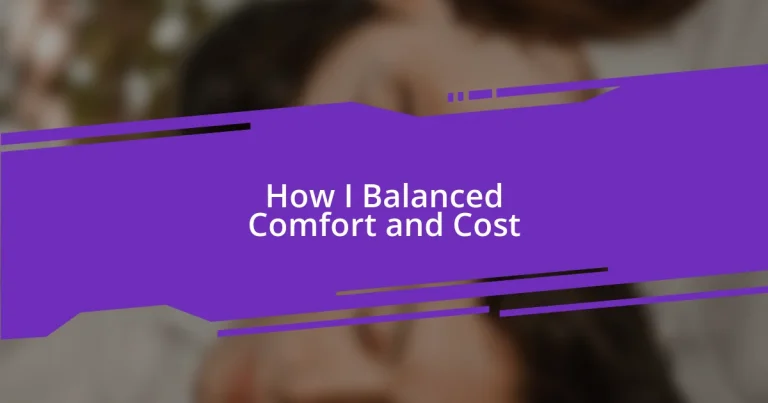Key takeaways:
- Investing in quality products enhances daily comfort and reduces long-term costs by minimizing the need for replacements.
- Evaluating genuine needs and prioritizing versatile, long-lasting items can lead to more satisfying purchases that align with personal values.
- Regularly reassessing comfort and cost ratios helps maintain balance and adapt to changing lifestyles for better living experiences.

Understanding Comfort and Cost
When I think about comfort, I often recall that moment when I discovered the perfect pair of shoes. They weren’t the cheapest option, but slipping them on felt like walking on clouds. It was a reminder that sometimes investing a bit more pays off in daily joy and well-being.
Cost and comfort seem to dance a delicate tango in our lives. Have you ever felt compelled to choose budget alternatives that left you unsatisfied? I certainly have. In my experience, these decisions often lead to regret, whether it was a low-quality sofa that had me yearning for a good night’s sleep or workout gear that didn’t support my active lifestyle.
Striking a balance between comfort and cost often requires us to evaluate our priorities. Are we choosing short-term savings over long-term satisfaction? I’ve learned that when I invest in a product that enhances my daily life, it ultimately saves me money in the long run by reducing the need for replacements.

Evaluating Your Needs
When I take a moment to evaluate my needs, I often find it helpful to consider what truly matters to me. For instance, there was a time when I spent weeks searching for a new mattress. I initially leaned towards the cheaper options, thinking I could save some cash. However, after a few restless nights on a budget model, I realized that my comfort and sleep quality were slipping away, leading me to reconsider my priorities.
To discern what you genuinely need, ask yourself these questions:
- How often will I use this item?
- Is comfort a top priority for me, or can I compromise?
- What are the potential long-term savings from choosing quality?
- Will this purchase affect my daily routines and overall happiness?
- Am I willing to invest more for better durability and satisfaction?
Reflecting on these questions can help clarify your needs and steer you toward choices that harmoniously blend comfort with cost.

Researching Affordable Options
When I’m on the hunt for affordable options, I often dive into online reviews before making a decision. For example, while shopping for a new office chair, I stumbled upon a gem—an ergonomic chair that offered great comfort at a reasonable price. It wasn’t the cheapest option, but the rave reviews highlighting its support and durability convinced me it was worth the investment. Reading other people’s experiences really helped me to navigate my choices and weigh the comfort against the cost.
I’ve also found that comparing products side-by-side can illuminate hidden advantages. Take, for instance, a recent search I did for sustainable sneakers. While one brand proudly boasted lower prices, another offered recycled materials and a stylish design that I couldn’t resist. It made me think about how sometimes spending a little more upfront aligns with my values, leading to a product that brings me joy and helps the planet.
Ultimately, it’s about discovering what makes sense for you. I often jot down key features that stand out in my option comparisons. It keeps me focused and avoids impulse buys. Here’s a simple comparison table that highlights some factors I consider during my research:
| Feature | Brand A | Brand B |
|---|---|---|
| Price | $50 | $70 |
| Comfort Level | Medium | High |
| Durability | 2 years | 5 years |
| Return Policy | 30 days | 90 days |
By keeping this process straightforward, I find it easier to balance comfort with cost effectively.

Prioritizing Long-Term Investment
When I think about long-term investment, I remember my initial experience buying a high-quality blender. At first, I was tempted by the cheaper options, but then I considered how often I’d use it. Wouldn’t I want a blender that could handle smoothies, soups, and even nut butters without falling apart? I decided to invest a bit more upfront, and years later, that trusty appliance is still my kitchen workhorse, proving that sometimes a higher price tag translates to greater value over time.
It’s also important to recognize the emotional impact of our purchases. I vividly recall the excitement I felt when I upgraded my smartphone to one offering better performance and longevity. The thrill wasn’t just in having the latest model; it was in knowing that I wouldn’t have to replace it in a couple of years. Reflecting on our buying decisions, how often do we weigh the joy and convenience a product brings into our lives? That deeper understanding often helps me justify spending a little extra for something that truly enhances my daily experience.
In the realm of furniture, I once faced the choice between a trendy sofa and a classic piece designed for durability. I stood in the store, pondering whether to follow fleeting trends or invest in timeless comfort. Ultimately, I chose the latter, and I still cherish that sofa today. It’s incredible how long-term investments can create spaces that feel like home, enriching our lives while reminding us of the value in prioritizing quality over fleeting trends.

Choosing Versatile Products
Choosing versatile products has been a game changer for me in managing comfort and cost. I remember buying a pair of shoes that not only looked great for casual outings but were also comfortable enough for long walks. It dawned on me how a single item could serve multiple purposes—it saved me both money and closet space. Have you ever thought about how much easier life would be if everything in your wardrobe multitasked just like that?
I often consider functionality when selecting versatile products. For instance, I found a stylish backpack that doubles as a work bag and a gym companion. Initially, I hesitated at the price, but I quickly realized it would replace two separate bags I’d otherwise have to buy. This thought process led me to assess how often I’d really use each item. Sometimes, investing in a well-designed product simplifies my life and aligns perfectly with my budget goals.
Another memorable purchase was a convertible coffee table. Not only does it serve as a centerpiece in my living room, but it also transforms into a dining surface when friends visit. I still recall hosting a small dinner party, with that table impressively accommodating everyone without sacrificing style. Isn’t it satisfying to have pieces in your home that serve more than one purpose? It truly enriches the living experience while keeping costs in check.

Making Cost-Effective Upgrades
Making cost-effective upgrades often hinges on finding that sweet spot where quality and budget intersect. I remember when I upgraded my showerhead. I stumbled upon a model that promised improved water pressure and required no extensive installation. The upfront cost was a little higher than standard options, but let me tell you, the refreshing feeling of a revitalizing shower transformed my mornings. Wouldn’t you agree that starting your day with a little luxury can make a huge difference?
Another instance was when I focused on updating my home’s lighting fixtures. I was shocked to find out how swapping out regular bulbs for energy-efficient LED ones not only enhanced the brightness but also cut down on my electricity bills. It was a simple upgrade that immediately elevated my living space. Have you ever experienced that surprising joy of utility meets aesthetic appeal? It’s those little changes—like illuminating your favorite reading nook—that truly make home feel like a sanctuary.
Then there’s my experience with integrating smart technology into my home. I hesitated at first, considering the cost of smart plugs and thermostats. But after looking at the potential savings on my energy bills, I dove in. Now, I can control my home’s temperature remotely, ensuring it’s always comfy when I arrive. Plus, joy comes from knowing I’m actively reducing my carbon footprint. Isn’t it amazing how investing in simple tech not only enhances convenience but could pay off in the long run?

Maintaining Balance Over Time
It’s interesting how maintaining balance over time requires a bit of mindfulness. I often take a step back to reassess my purchases. For instance, after a year of using a multifunctional sofa bed, I realized it became a cozy spot for guests and a great reading nook for me. It’s heartwarming to think how a single piece of furniture can bring both comfort and efficiency to my space. Have you ever found yourself appreciating a particular item in your home because of the joy and usefulness it brings?
I also believe that regularly evaluating my comfort-cost ratio is key. Last summer, I revisited my outdoor furniture. I had invested in a set that initially seemed pricey, but after a season of enjoyable evenings with friends around the fire pit, the value was undeniable. Each gathering reminded me that spending a bit more for quality translates into experiences that enrich my life. Can you remember a time when something you thought was an extravagant purchase turned into a beloved staple?
Then there’s the challenge of adapting to changing needs. I recently swapped out a desk that served me well for years, realizing it no longer fit my workspace dynamics. The new desk, while a bit more expensive, has adjustable height features that cater to my work-from-home lifestyle. It’s a perfect example of how investing in comfort and functionality can evolve with our circumstances. Isn’t it empowering to find solutions that cater to our changing needs while still keeping a close watch on our budget?














